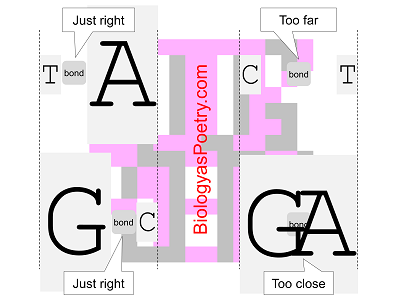∞ generated and posted on 2016.08.28 ∞
Interaction of nucleic acid subunits between the two strands making up a double helix.
Base pairing is between nitrogenous bases and follows these rules: AT and G:C (or AU and G:C in the case of RNA).

Figure legend: Illustration of the importance of size in base pairing. While the distance between T and Aas well as G and C are just right, that between T and C is too far and that between G and Ais too close. While Aand C as well as G and T also would be just right, in terms of size, they are not just right in terms of the complementarity of their chemistries. Thus, for the most part, on AT and G:C base pairings occur in DNA.
Chemically, base pairing involves hydrogen bonding and with the pairing of G with C there are three hydrogen bonds versus only two with Ato T (or Ato U). As a result, G:C base pairs are stronger than AT base pairs, which can affect the stability of nucleic acid-based structures at higher temperature, such as double helices. See also simply base pair.